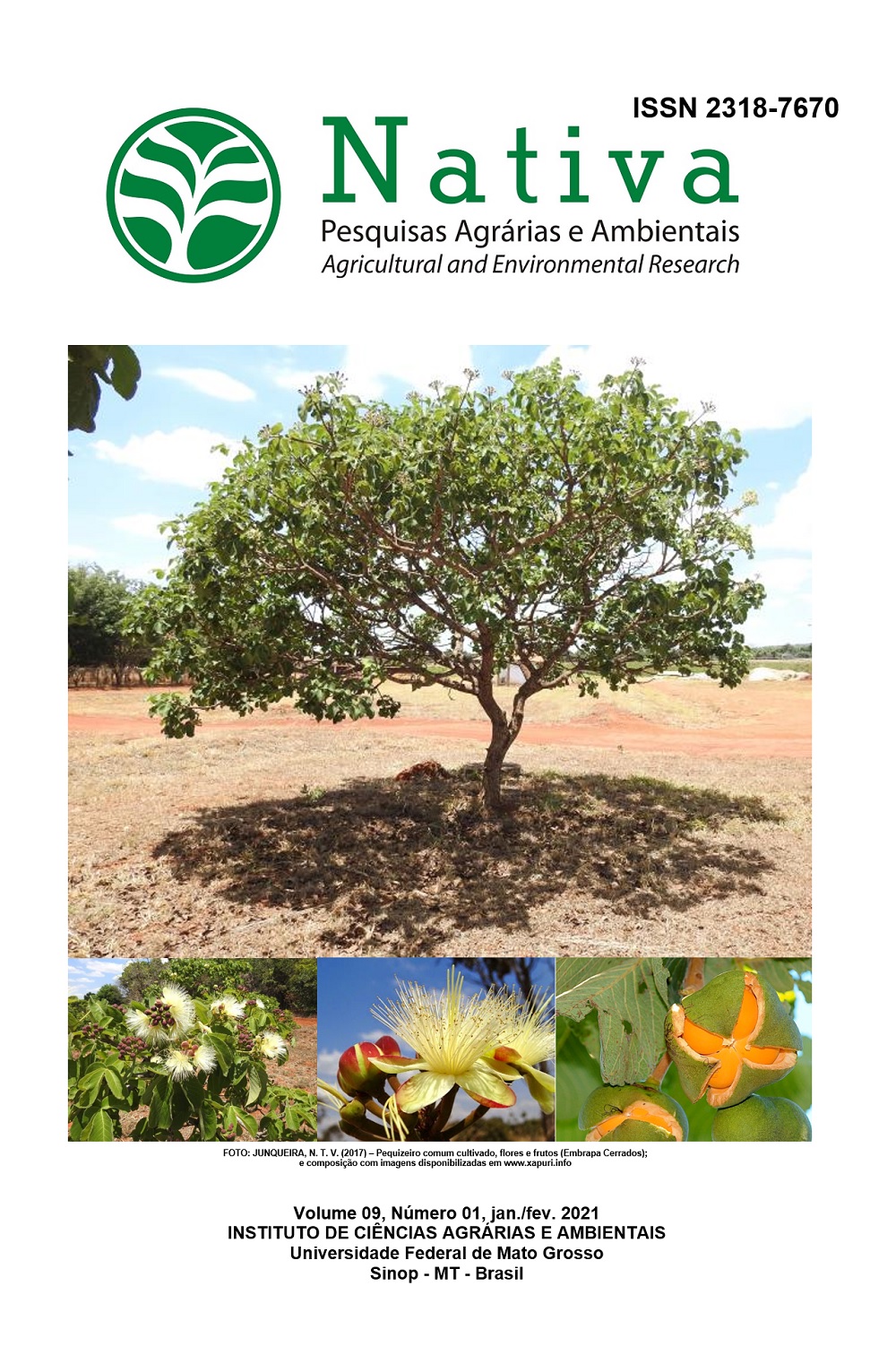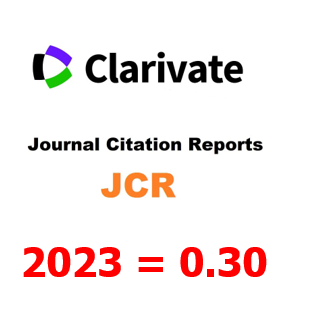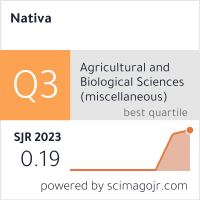PERFORMANCE DA MODELAGEM PARA CLASSIFICAÇÃO DE SÍTIOS FLORESTAIS EM BASES DE DADOS COM OUTLIERS
DOI:
https://doi.org/10.31413/nativa.v9i1.11202Palavras-chave:
índice de sítio, inventário florestal, dados discrepantesResumo
As informações utilizadas para estimativa da capacidade produtiva de sítios florestais provêm de bases de dados de inventário florestal que podem conter observações discrepantes (outliers). Assim, torna-se necessário a análise de consistência para exclusão destes. Porém, os outliers podem representar determinado padrão de crescimento existente na floresta, logo a exclusão destes pode ser uma ação equivocada. Objetivou-se comparar a performance de diferentes técnicas de modelagem para classificação de sítios florestais, considerando uma base de dados com a presença de outliers. Utilizou-se pares de dados de idade e altura dominante (HD) de parcelas permanentes de Eucalyptus urophyla x Eucalyptus grandis localizadas no norte de Minas Gerais. Foi simulado um outlier de HD. A base de dados foi modelada, com e sem presença de outliers, por regressão linear (RL) e redes neurais artificiais Multilayer Perceptron (MLP) e Radial Basis Function (RBF). Os métodos foram analisados por meio dos critérios estatísticos de precisão: bias, raiz quadrada do erro médio, correlação de Pearson, erro médio percentual e gráfico de dispersão residual. A MLP foi superior para estimativa do índice de sítio. Portanto, a MLP é indicada para classificação de sítios florestais quando há presença de outliers na base de dados.
Palavras-chave: índice de sítio; inventário florestal; dados discrepantes.
Performance of modeling for classification of forest sites in databases with outliers
ABSTRACT: The information used to estimate the productive capacity of forest sites comes from forest inventory databases that may contain discrepant observations (outliers). Thus, consistency analysis is required to exclude these. However, the outliers may represent a certain growth pattern existing in the forest, so their exclusion may be a mistaken action. The objective was to compare the performance of different modeling techniques for forest site classification, considering a database with the presence of outliers. We used pairs of data of age and dominant height (HD) of permanent parcels of Eucalyptus urophila x Eucalyptus grandis located in the north of Minas Gerais. A HD outlier was simulated. The database was modeled, with and without the presence of outliers, by linear regression (RL) and artificial neural networks Multilayer Perceptron (MLP) and Radial Basis Function (RBF). The methods were analyzed by means of precision statistical criteria: bias, square root of mean error, Pearson correlation, mean percentage error and residual scatter plot. The MLP was superior for site index estimation. Therefore, the MLP is indicated for forest site classification when there are outliers in the database.
Keywords: site index; forest inventory; discrepant data.
Referências
ARAÚJO JÚNIOR, C. A.; SOARES, C. P. B.; LEITE H. G. Regressão quantílica para gerar curvas de índice de sítio em povoamentos de eucalipto no Brasil. Pesquisa Agropecuária Brasileira, Brasília, v. 51, n. 6, p. 720-727, 2016. DOI: http://dx.doi.org/10.1590/S0100-204X2016000600003
ARAÚJO JÚNIOR, C. A.; SOUZA, P. D.; ASSIS, A. L.; CABACINHA, C. D.; LEITE, H. G.; SOARES, C. P. B.; SILVA, A. A. L.; CASTRO R. V. O. Artificial neural networks, quantile regression, and linear regression for site index prediction in the presence of outliers. Pesquisa agropecuária Brasileira, Brasília, v. 54, n. 1, p. 1-8, 2019. DOI: 10.1590/S1678-3921.pab2019.v54.00078
ARTERO, A. O. Inteligência Artificial: teoria e prática. 1 ed. São Paulo: Livraria da Física, 2009. 230p.
ASSMAN E. The principles of forest yield study. 5.ed. Oxford: Pergamon Press, 1970. 506p.
BINOTI, M. L. M. S.; BINOTI, D. H. B.; LEITE, H. G. Aplicação de redes neurais artificiais para estimação da altura de povoamentos equiâneos de eucalipto. Revista Árvore, Viçosa, v. 37, n. 4, p. 639-645, 2013. DOI: http://dx.doi.org/10.1590/S0100-67622013000400007
BINOTI, M. L. M. S.; LEITE, H. G.; BINOTI, D. H. B.; GLERIANE, J. M. Prognose Em Nível De Povoamento de clones de eucalipto empregando redes neurais artificiais. Cerne, Lavras, v. 21, n. 1, p. 97-105, 2015. DOI: https://doi.org/10.1590/01047760201521011153
BRAGA, A. P.; CARVALHO, A. P. L. P.; LUDEMIR, T. B. Redes Neurais Artificiais: Teoria e Aplicações. 2 ed. Rio de Janeiro: LTC, 2014. 226p.
CAMPOS J. C. C.; LEITE H. G. Mensuração florestal: perguntas e respostas. 4 ed. Viçosa: UFV, 2013. 605p.
CHAVES, A. G. S.; DRESHER, R.; CALDEIRA, S. F.; MARTINEZ, D. T.; VENDRUSCOLO, D. G. S. Capacidade produtiva de Tectona grandis L. f. no Sudoeste de Mato Grosso. Scientia Florestalis, Piracicaba, v. 44 n. 110, p. 415-416, jun. 2016. DOI: http://dx.doi.org/10.18671/scifor.v44n110.14
COSENZA, D. N.; LEITE, H. G.; MARCATTI, E. G.; BINOTI, D. H. B.; ALCÂNTARA, A. E. M.; RODE R. Classificação da capacidade produtiva de sítios florestais utilizando máquina de vetor de suporte e rede neural artificial. Scientia Forestalis, Piracicaba, v. 43, n. 108, p. 955-963, dez. 2015. DOI: http://dx.doi.org/10.18671/scifor.v43n108.19
CORDEIRO, M. A.; PEREIRA, N. N. J.; BINOTI, D. H. B.; BINOTI, M. L. M. S. Estimativa do volume de Acacia mangium utilizando técnicas de redes neurais artificiais e máquinas vetor de suporte. Pesquisa Florestal Brasileira, Colombo, v. 35, n. 83, p. 255-261, 2015. DOI: 10.4336/2015.pfb.35.83.596
DIAMANTOPOULOU, M. J.; ÖZÇELIK, R.; CRECENTE-CAMPO, F.; ELER, U. Estimation of Weibull function parameters for modelling tree diameter distribution using least squares and artificial neural networks methods. Biosystems Engineering, Northumberland, v. 133, p. 33-45, mar. 2015. DOI: http://dx.doi.org/10.1016/j.biosystemseng.2015.02.013
ERCANLI, İ.; GÜNLÜ, A.; KELEŞ, S. Artificial neural network models predicting the leaf area index: a case study in pure even-aged Crimean pine forests from Turkey. Forests Ecosystems, v. 5, n. 29, p. 2-12, 2018. DOI: https://doi.org/10.1186/s40663-018-0149-8.
HAYKIN, S. Redes Neurais: princípios e prática. 2.ed. Porto Alegre: Bookman, 2002. 900p.
GUJARATI, D. N.; PORTER, D. C. Basic Econometric. 5 ed. New York: AMGH, 2011. 924p.
LEITE, H. G.; SILVA, M. L. M.; BINOTI, D. H. B.; FARDIN, L.; TAKIZAWA, F. H. Estimation of inside-bark diameter and heartwood diameter for Tectona grandis Linn. trees using artificial neural networks. European Journal of Forest Research, München, v. 130, n. 2, p. 263-269, ago. 2010, DOI: http://dx.doi.org/10.1007/s10342-010-0427-7
MACHADO, S. A.; OLIVEIRA, E. B.; CARPANEZZI, A. A.; BARTOSZECK, A. C. P. S. Classificação de sítio para bracatingais na região metropolitana de Curitiba. Boletim de Pesquisa Florestal, Colombo, v. 35, n. 1, p. 21-37, jul./dez. 1997.
ÖZÇELIK, R.; DIAMANTOPOULOU, M. J.; CRECENTE-CAMPO, F.; ELER, U. Estimating Crimean juniper tree height using nonlinear regression and artificial neural network models. Forest Ecology and Management, v. 306, p. 52-60, 2013. DOI: https://doi.org/10.1016/j.foreco.2013.06.009
R Core Team. R: a language and environment for statistical computing. Vienna: R Foundation for Statistical Computing, 2014. Disponível em: . Acesso em: 10 jul. 2019.
RIBEIRO, R. B. S.; GAMA, J. R. V.; SOUZA, A. L.; LEITE, H. G.; SOARES, C. P.; SILVA, G. F. Métodos para estimar o volume de fustes e galhos na floresta nacional do Tapajós. Revista Árvore, Viçosa, v. 40, n. 1, p. 81-88, jan./fev. 2016. DOI: https://doi.org/10.1590/0100-67622016000100009
SCHNEIDER, P. R.; SCHNEIDER, P. S. P.; SOUZA C. A. M. Análise de regressão aplicada à engenharia florestal. Santa Maria: FACOS-UFSM, 2009. 294p.
SCOLFORO, J. R. S. Biometria Florestal – Modelos de Crescimento e Produção. Lavras: UFLA-Fundação de apoio ao Ensino, Pesquisa e Extensão, 2006. 355p.
SILVA, M. L. M.; BINOTI, D. H. B.; GLERIANI, J. M. Ajuste do modelo de Schumacher e Hall e aplicação de redes neurais artificiais para estimar volume de árvores de eucalipto. Revista Árvore, Viçosa, v. 33, n. 6, p. 1133-1139, 2009. DOI: http://dx.doi.org/10.1590/S0100-67622009000600015
VENDRUSCOLO, D. G. S.; CHAVES, A. G. S.; MEDEIROS, R. A.; SILVA, R. S.; SOUZA, H. S.; DRESCHER, R.; LEITE, H. G. Estimativa da altura de árvores de Tectona grandis L.f. utilizando regressão e redes neurais artificiais. Nativa, Sinop, v. 5, n. 1, p. 52-58, jan./fev. 2017. DOI: http://dx.doi.org/10.5935/2318-7670.v05n01a09
Publicado
Versões
- 2023-09-29 (2)
- 2021-02-10 (1)
Edição
Seção
Como Citar
Licença
Copyright (c) 2021 Nativa

Este trabalho está licenciado sob uma licença Creative Commons Attribution-NonCommercial 4.0 International License.
Direitos Autorais para artigos publicados nesta revista são do autor, com direitos de primeira publicação para a revista. Em virtude de a aparecerem nesta revista de acesso público, os artigos são de uso gratuito, com atribuições próprias, em aplicações educacionais e não-comerciais.
A artigos publicados nessa revista, podem ser reproduzidos parcialmente ou utilizados como referência por outros autores, desde que seja cita a fonte, ou seja, a Revista Nativa.
Copyright for articles published in this journal are the authors, with first publication rights granted to the journal. The journal shows open access, and articles are free to use, with proper attribution, in educational and non-commercial.
The articles published in this journal may be reproduced in part or used as a reference by other authors, provided that the source is quoted.






